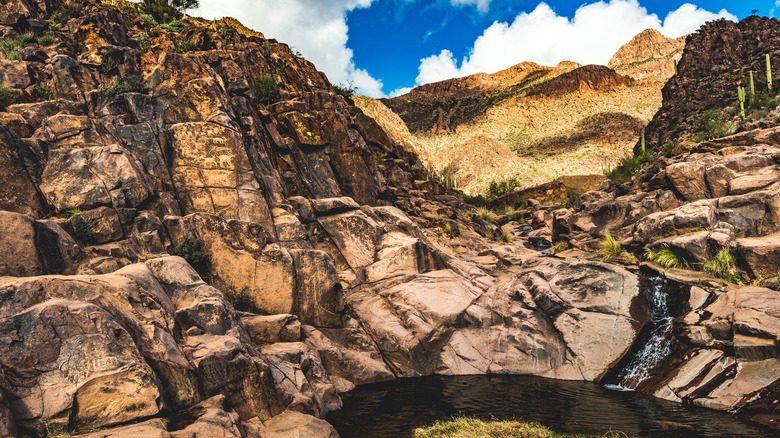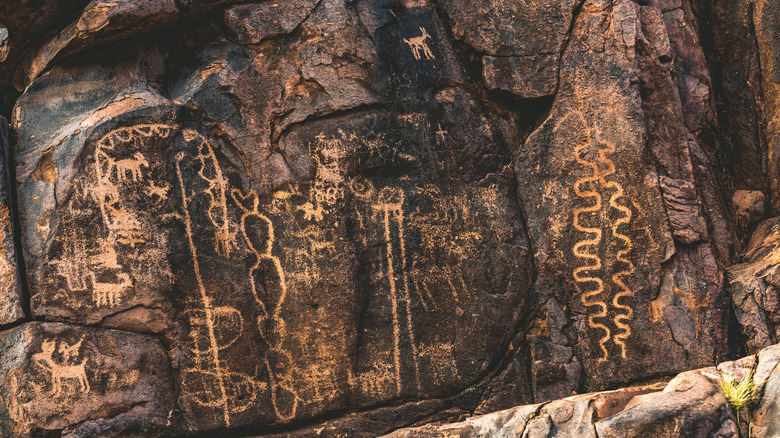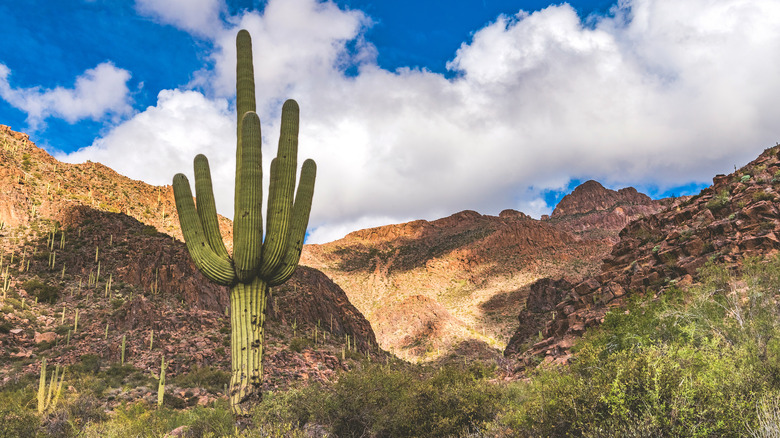A Short But Stunning Arizona Trail Showcases Rugged Canyons, Wildflowers, And Ancient Rock Petroglyphs
Sand-baked desert, superstition, hieroglyphics ... no, this isn't actually a description of the iconic '90s classic, "The Mummy" but of a trail less than an hour from downtown Phoenix. The Hieroglyphic Trail is a 3-mile out-and-back route in the Superstition Wilderness that passes through a postcard-worthy Sonoran landscape of ancient saguaros, teddy bear chollas, and wildflowers peppered among volcanic rocks and boulders. It ends up in a rugged canyon where you'll find ancient 1,500-year-old petroglyphs done by the Hohokam people.
The name is a bit of a misnomer, since hieroglyphs refer to a pictorial-style writing typically associated with the ancient Egyptians, while petroglyphs are rock carvings usually done by Indigenous tribes. Petroglyphs aren't graffiti or rock art; instead, they're cultural and religious markers intricately integrated with and relational to the surrounding landscape.
While Phoenix has its fair share of scenic hikes with epic views and petroglyphs, the Hieroglyphic Trail is easy and family-friendly, making it a favorite for locals and visitors alike. For something extra special, you might want to do it after a big rain to see water trickling down the petroglyphs into otherwise empty rock pools.
What to expect on the Hieroglyphic Trail
The Hieroglyphic Trail is quite straightforward, although a bit rocky, so good, sturdy hiking shoes are recommended. It begins at the Lost Goldmine Trail, which quickly veers off into the Hieroglyphic Trail that begins just inside the bounds of the Superstition Wilderness (be sure to close the gate that's there for animals once you reach it). Along the way, enjoy the sight of barrel cacti and giant 200-year-old saguaros as well as sweeping views of Gold Canyon and the Gila River plain. If you go in spring, you might see vibrant cactus blooms and wildflowers like coreopsis and blue dicks. Whenever you go, be sure to watch out for rattlesnakes.
The trail then leads into a canyon filled with boulders and some rock pools that are often filled with water. This is where you'll find the petroglyphs on the left, all under the towering peaks of the Superstition Mountains, home of stunning natural beauty and Arizona's last stagecoach town. You have to scramble over some boulders to see these fascinating and evocative carvings of geometric shapes and animals like bighorn sheep and deer. Note that these petroglyphs are protected under the Antiquities Act, so adding your own "petroglyphs" to the site or defacing the original ones could lead to fines or even jail time (besides that, it's just plain old tacky to mess with archaeological sites). As with all hikes, leave no trace around the petroglyphs, which have remained intact for centuries.
Those looking for an extra challenge can continue on the Hieroglyphic Trail to the Superstition Ridgeline Trail, which leads to Peak 5057, the tallest in the Superstition Mountains. Note that this latter trail is for experienced hikers only and is not well marked.
How to get to the Hieroglyphic Trail
Perhaps not surprisingly, the Hieroglyphic Trail is a popular hike, especially on weekends and during good weather. One way to avoid the crowds is to go early or on a weekday, which will also increase your chances of finding parking in the small lot, particularly since you can't park along the road in the area around the trailhead. If the lot is full, unfortunately, you might just have to circle and wait. And if you get bored waiting, you can always drive farther north into the Tonto National Forest, where you can see wonders like the world's largest natural travertine bridge.
If you can, time the hike so that you do it after a few days of rain, which typically occurs in the spring from January to March and during monsoon season from July to September (however, it is exposed and extremely hot here in summer, so bring adequate water and sun protection). Heavy rains will fill the pools around the petroglyphs with water and may even create a cascade along the rocks, which adds another evocative layer to what's already a mystical place. If this is of interest, you can check recent photos posted on the AllTrails site or app to see the state of the pools and plan your hike accordingly.
There are basic bathrooms and a trash bin at the start of the trail. Dogs are allowed as well but must be on a leash. The closest airport is Phoenix Sky Harbor International Airport, 45 minutes away by car.


